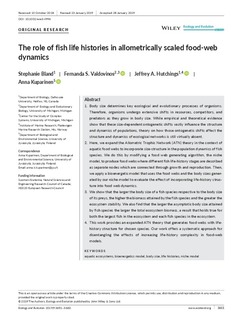| dc.description.abstract | Body size determines key ecological and evolutionary processes of organisms. Therefore, organisms undergo extensive shifts in resources, competitors, and predators as they grow in body size. While empirical and theoretical evidence show that these size‐dependent ontogenetic shifts vastly influence the structure and dynamics of populations, theory on how those ontogenetic shifts affect the structure and dynamics of ecological networks is still virtually absent.
Here, we expand the Allometric Trophic Network (ATN) theory in the context of aquatic food webs to incorporate size‐structure in the population dynamics of fish species. We do this by modifying a food web generating algorithm, the niche model, to produce food webs where different fish life‐history stages are described as separate nodes which are connected through growth and reproduction. Then, we apply a bioenergetic model that uses the food webs and the body sizes generated by our niche model to evaluate the effect of incorporating life‐history structure into food web dynamics.
We show that the larger the body size of a fish species respective to the body size of its preys, the higher the biomass attained by the fish species and the greater the ecosystem stability. We also find that the larger the asymptotic body size attained by fish species the larger the total ecosystem biomass, a result that holds true for both the largest fish in the ecosystem and each fish species in the ecosystem.
This work provides an expanded ATN theory that generates food webs with life‐history structure for chosen species. Our work offers a systematic approach for disentangling the effects of increasing life‐history complexity in food‐web models. | nb_NO |
